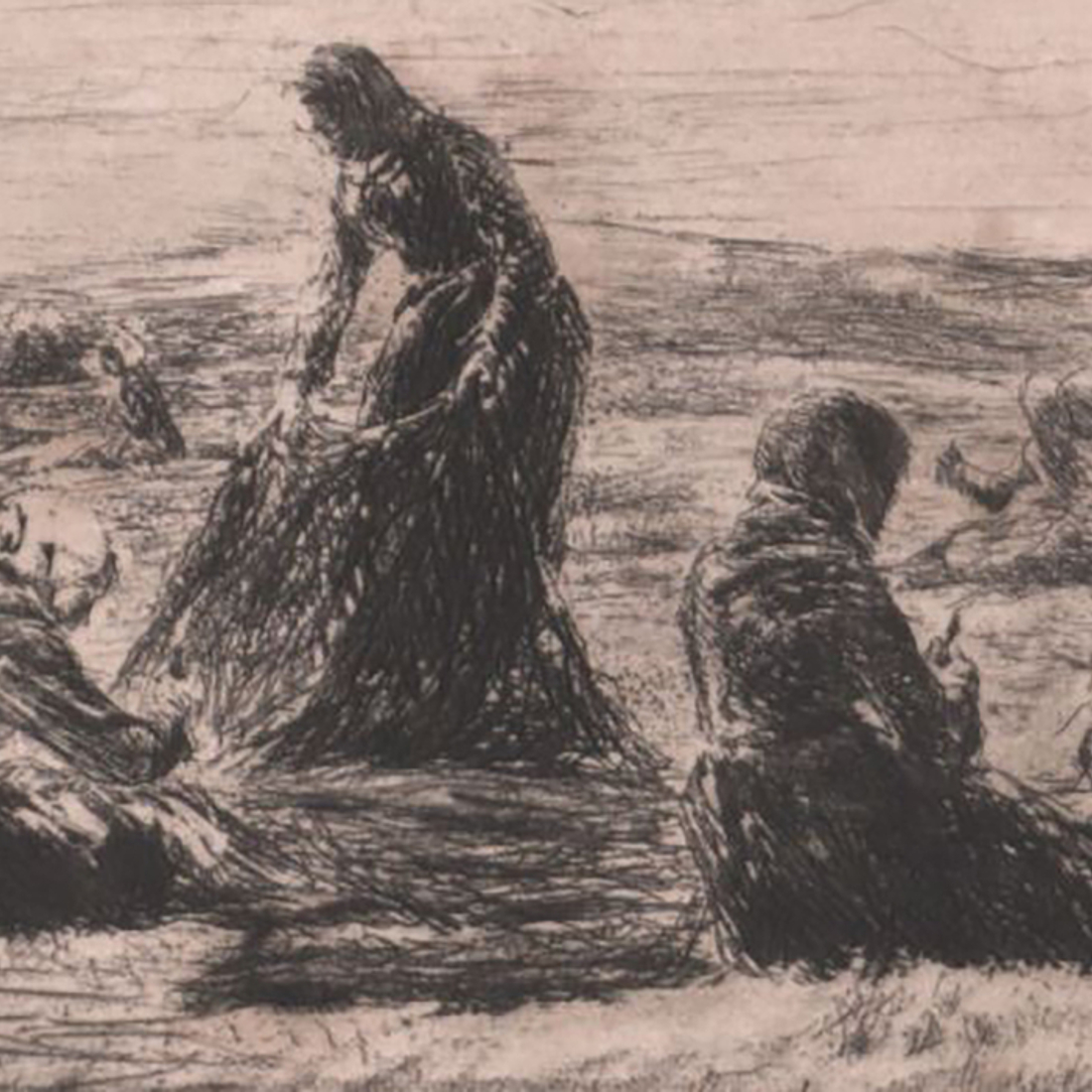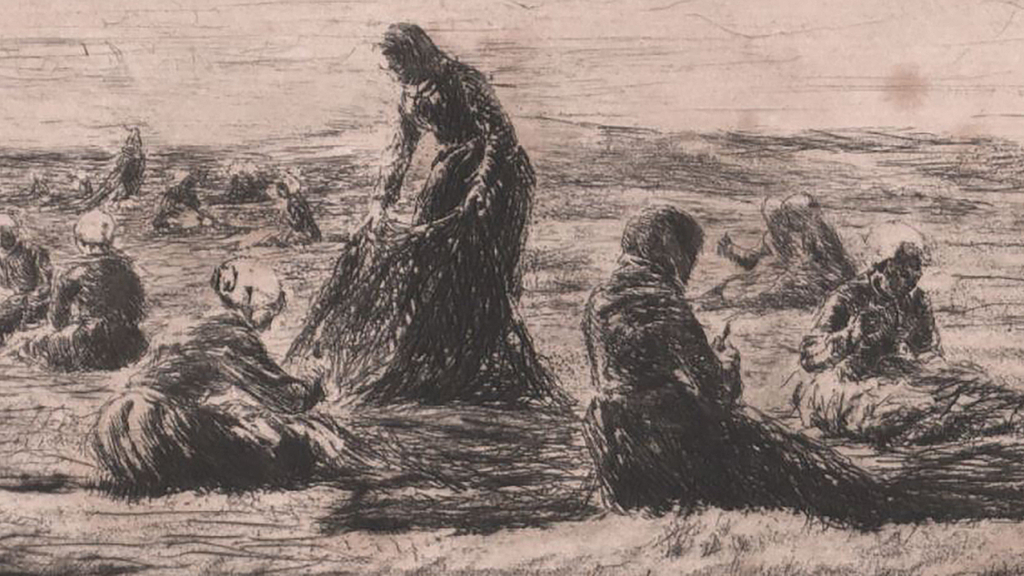Archive of the month: etching by Max Liebermann
In the series "Archive of the Month", the German Maritime Museum (DSM) / Leibniz Institute of Maritime History regularly presents a special treasure from the archive. Fittingly for the birth month of the artist Max Liebermann, the focus in July is on one of his etchings. The DSM archive owns the maritime work "Die Netzflickerinnen" by the important impressionist. It was created after a pencil study from 1894.
Since 2000, the DSM archive has owned the etching "Die Netzflickerinnen" by Max Liebermann. Max Liebermann - born on July 20, 1847, died on February 8, 1935 in Berlin - is one of the most important artists of German Impressionism. He painted the image of his surroundings precisely, clearly and at the same time vividly.
In addition to portraits, landscapes and depictions of bourgeois life, Max Liebermann also captured everyday scenes and simple working worlds of weavers, peasants and net-makers. The depiction of these rustic, sometimes poor scenes was initially highly controversial at the time: critics dismissed them as "trivial" because they contrasted with the depictions of battles, heroes, or the Bible that were common at the time. But Liebermann did not want his pictures to be understood as trivial or even as a social indictment; rather, he was searching for the beauty and meaning of simple life. This is also the case in the etching "The Net Mending Women" in the DSM.
The graphic "The net mending women" belongs to a series of representations that always show the same genre theme: Women squatting or rarely standing on a meadow mending fishing nets. The artist had come across the motif of the net mending women in 1884 during his honeymoon in Scheveningen, Holland. In numerous drawings and oil studies, Max Liebermann realized the theme, until a few years later he presented a large-scale oil painting at the Paris World's Fair in 1889. In Hamburg, the then director of the Hamburger Kunsthalle, Alfred Lichtwark, recognized the signs of the times: he purchased the painting of the net flicker, a great success for the artist, especially after the negative criticism. Moreover, it was the first work by Max Liebermann to enter a museum (inv. no. HK-1580).
The etching was created by Max Liebermann a few years later, in 1894. It probably goes directly back to a pencil study, which is now in the Kupferstichkabinett of the Hamburger Kunsthalle (HK Inv. No.: 1924-463). Depicted are squatting women who are oriented to the coastline, which remains hidden from the viewer, are placed in the landscape space and almost merge with the field. Only one of the women rises to inspect her work. She is also the only one of the women to break the almost straight horizon line that separates the low-lying sky from the landscape; the impression is of a boundless expanse, so typical of the Dutch coast. Thick spring clouds pile up above the women - unperturbed, they go about their work with concentration. The wind, coming from the nearby sea, blows gently over the leaning grass. Despite the clouds, this composition radiates an unchanging, constant calm.
Max Liebermann here gives us a glimpse into a world where life by the sea suggested both a source of sustenance and a clear division of roles. While the men were at sea, the women did their work on land. He shows us the women's perspective, their hard manual labor and stoic endurance. Without seeing the fishermen at sea, we can guess that they are resigned to their fate.
The DSM etching measures 22 x 30 cm (plate), 41 x 49.3 cm (sheet); the work is signed Liebermann directly on the plate. There is a dry stamp on the paper; there is also a fingerprint in the lower left corner of the image, which must have been made when the print was printed. Overall, the state of preservation of the etching can be described as good, the paper is slightly stained due to its age. In addition, two different earlier framings are recognizable, as the paper appears darkened in two phases. According to Max Liebermann's catalog raisonné by Gustav Schiefler, Max Liebermann. Sein graphisches Werk 1876-1923 (4th edition, San Francisco 1991), the work in question is the one under no. 33 Netzflickerinnen. Etching, drypoint) described III state (possibly III a/a).
Little is known so far about the exact origin - the provenance - of the etching: When the print was acquired from the art trade, no information about other previous owners was provided at the time. For possibly comparable etchings under the titles "Netzflickerinnen in Landschaft" or "Netzflickerinnen" by Max Liebermann, several search notifications were published in the LostArt database. The LostArt database is used to post reports of sought and found so-called looted art that was seized from its owners during the Nazi regime as a result of persecution. Despite intensive research, it has not yet been possible to identify the etching in the DSM with the etchings sought via LostArt. Particularly in the case of serially produced artworks and prints published in larger editions, which rarely exhibit individual characteristics, the clear provenance is extremely difficult to trace without additional information.
Overview archives of the month
Archive of the Month: Treasure from the Archive
Archive of the Month in January: From New York to Bremen 1859
Archive of the month for February: Photos of the small cruiser MEDUSA
Archive of the month in April: The engine journal of the Bremen icebreaker DONAR
Archive of the Month in May: The Diary of Caroline von Aschen


